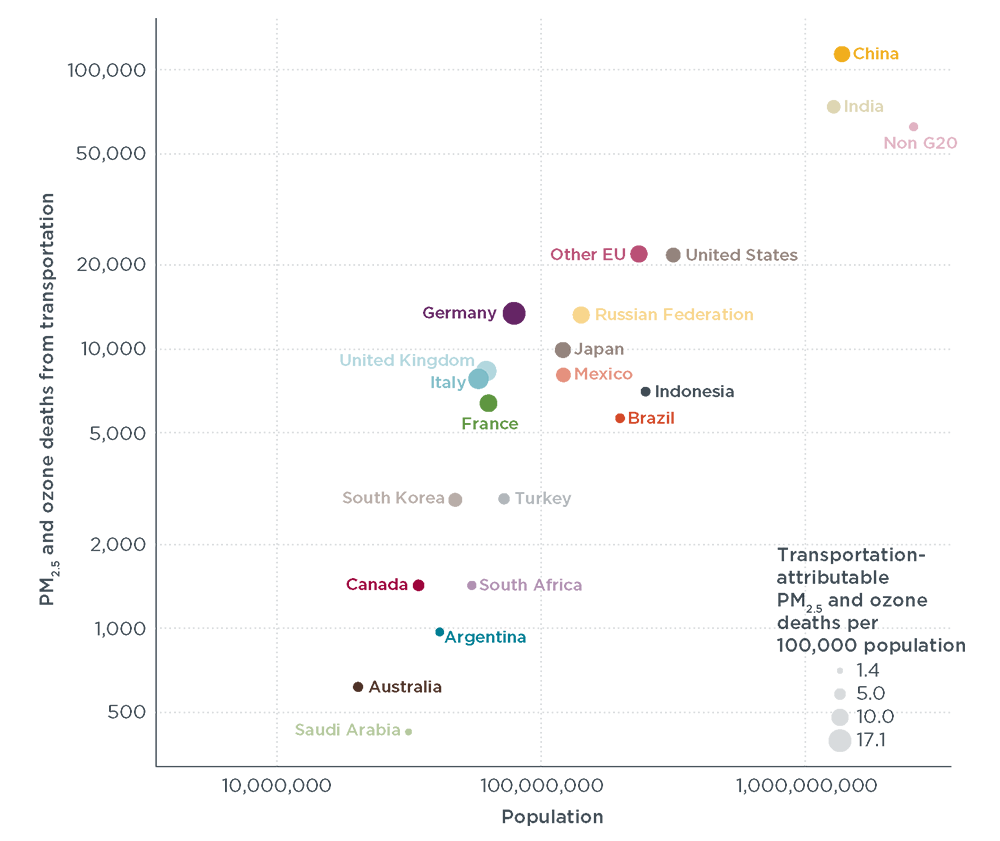Report
A global snapshot of the air pollution-related health impacts of transportation sector emissions in 2010 and 2015
Exhaust from vehicles is a major source of outdoor air pollution worldwide. This study links state-of-the-art vehicle emissions, air pollution, and epidemiological models to estimate the impacts of transportation sector emissions on ambient PM2.5 and ozone and associated health impacts in 2010 and 2015. It provides a detailed picture of the global, regional, and local health impacts attributable to emissions from four transportation subsectors: on-road diesel vehicles, other on-road vehicles, shipping, and non-road mobile engines such as agricultural and construction equipment.
The study links vehicle tailpipe emissions to ~361,000 premature deaths from ambient PM2.5 and ozone worldwide in 2010 and ~385,000 in 2015, equivalent to 11.7% of global ambient PM2.5 and ozone premature deaths in 2010 and 11.4% in 2015. An estimated 84% of global transportation-attributable deaths occurred in G20 countries, and 70% occurred in the four largest vehicle markets in 2015: China, India, the European Union, and the United States. Exhaust from on-road diesel vehicles was responsible for nearly half of the impacts (~181,000 premature deaths) worldwide, and fully two-thirds in India, France, Germany, and Italy. Together, PM2.5 and ozone concentrations from transportation emissions resulted in 7.8 million years of life lost and approximately $1 trillion (2015 US$) in health damages globally in 2015.
The urban areas with the highest number of transportation-attributable air pollution in 2015 were Guangzhou, Tokyo, Shanghai, Mexico City, Cairo, New Delhi, Moscow, Beijing, London, and Los Angeles. By contrast, when normalized by population, the urban areas with the highest number of transportation-attributable air pollution deaths per 100,000 people were Milan, Turin, Stuttgart, Kiev, Cologne, Haarlem, Berlin, Rotterdam, London, and Leeds.
Despite recent adoption of more stringent vehicle emission regulations in some major vehicle markets, the transportation sector remains a major contributor to the air pollution disease burden globally. This points to the need for reducing emissions from the transportation sector to be a central element of national and local management plans aimed at reducing ambient air pollution and its burden on public health. Wherever world-class vehicle emissions standards have not yet been adopted, countries and trade blocs should avoid continuation of the considerable public health damages highlighted in this report by accelerating their adoption. The experiences of the top vehicle markets underscore the substantial time lag between implementation of new vehicle standards and the realization of their full benefits for the in-use vehicle fleet that results from the long lifetimes of vehicles and equipment. Countries and trade blocs that already have adopted world-class vehicle emission standards should consider accelerating the expected public health benefits with strategies to reduce emissions from in-use vehicles, such as low emission zones, retrofit/replacement/scrappage programs, and targeted fleet renewal. Urban areas and subnational jurisdictions can justify more ambitious actions because of their disproportionate exposure to transportation emissions.

Attachments
Paris_pollution_heath_issues_transport_factsheet_20190226.pdf
London_pollution_heath_issues_transport_factsheet_20190226.pdf
Germany_pollution_heath_transport_factsheet_20190226.pdf
Germany_DE_pollution_heath_transport_factsheet_20190226.pdf
health-impacts-transport-emissions-2015-by-region.xlsx
Transportation-impacts-public-presentation.pdf
ICCT_factsheet_health_impact_airpollution_Delhi_20190705.pdf
